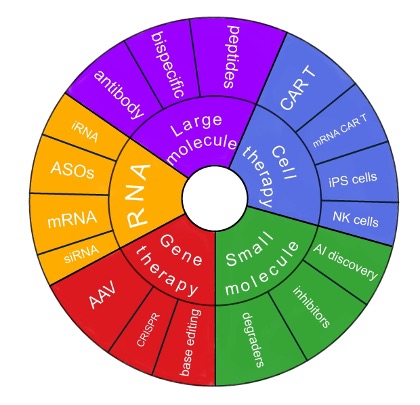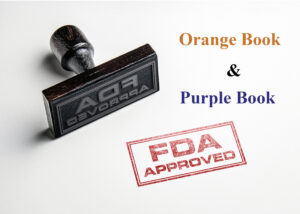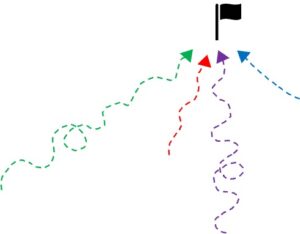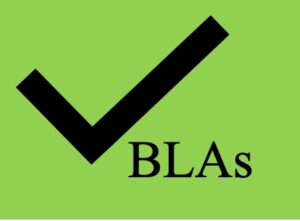If you are confused as to what exactly a therapeutic is, you are not alone. The term can be confusing because it is used interchangeably with modality, drug, API, active agent, small molecule, large molecule, etc. In fact, there are many terms that are used to describe a therapeutic. Some are vague and nondescript, and some are very specific.
Broadly, a therapeutic or a modality is something that is administered to a patient to treat a disease or disorder, or the symptoms of a disease or disorder. In short, it is something that is administered to a patient to treat the patient.
For example, for a patient suffering from a heart-related condition, treatments may include surgery, a change in diet (reduction in salt and alcohol), a change in behavior (exercising and ceasing smoking), or taking a medication, such as a statin. There are many treatment options. But a therapeutic or modality is something that is administered to the patient to treat the patient. Administered means something swallowed, inhaled, injected, applied topically, etc. Surgery is not administered to a patient. While a medication, like a statin, is administered to the patient.
That something that is administered to the patient to treat a disease or disorder can be a wide variety of things. It can be a vaccine, pill, injection, solution, infusion, powder, etc. The therapeutic is not the pill, capsule, gel, powder, or solution. The therapeutic is in that pill, injection, solution, powder, etc. It is the specific thing, like a molecule, that causes the biological effect that treats the disease, disorder, or symptom. It can be a small molecule, an antibody, a collection of cells, or an oligonucleotide.
And that something, that therapeutic or modality, generally falls within one of five main classes of therapeutics: small molecules, large molecules, gene therapy, cell therapy, and RNA therapy.
Large molecules
Large molecules are also called big molecules or protein-based therapeutics. They are made up of proteins, or specifically, amino acids. The types of therapeutics in this class include antibodies, bispecifics, peptides, fusion proteins, small proteins, etc.
Small molecules
Large molecules and small molecules are distinguished based on their size. But there are other key differences between small molecules and large molecules. Such as how they are manufactured, how they are administered, and their mechanisms of action. Small molecules can include inhibitors, agonists, degraders, and molecular glues.
Gene therapy
The goal of gene therapy is to alter the expression of a gene. Either to cause or increase expression of a gene or to prevent or reduce expression of a gene. This can be accomplished by gene addition or gene editing. An important aspect of gene therapy is the delivery of the genetic material to cells, which can be accomplished by viral and non-viral delivery vehicles.
Cell therapy
Cell therapy involves administering cells (stem cells and non-stem cells) to a patient. The cells may, or may not, be genetically altered. Cell therapy includes the administration of stem cells, iPS cells, CAR T cells, NK cells, and NK CAR T cells.
RNA therapy
RNA therapy involves strategies to either introduce RNA into cells to be translated or to prevent the translation of RNA. Generally, RNA therapy includes RNA addition or RNA silencing (also called RNA interference). RNA therapy includes therapeutics such as ASOs, mRNA, siRNA, and miRNAs.
These five main classes of therapeutics differ vastly in their structures or compositions, mechanisms of action, routes of administration, and targets in the body. Any professional in life sciences, biotechnology, or pharmaceuticals needs to understand these five main classes of therapeutics. It is essential to not only understand how they differ but also how the technologies in each of these five main classes can be mixed or combined to form new classes of therapeutics. For example, CAR T cell therapy leverages antibody technology and T cells. ADCs leverage small molecules and large molecules.
It should be noted that these classes of therapeutics have overlapping technologies. For example, oligonucleotides are used in both gene therapy and RNA therapy. However, they have different compositions based on whether they are leveraged in gene or RNA therapy. There is also overlap when it comes to antibody technology. Antibody technology is leveraged in large molecule therapeutics and in cell therapies. In essence, it is important to not only understand one class of therapeutics but all five.
An understanding of the five main classes of therapeutics and modalities is essential to understanding how these different types of therapeutics can be leveraged to treat specific diseases and disorders. For example, various companies in the cardiovascular field may be developing different therapeutics. One company may be developing a small molecule, one may be developing a gene therapy, and one may be developing an siRNA. Each company is developing a different therapeutic, but they may be competing for the same patient population.
The Executive Course on Therapeutics and Modalities is an introduction to the five main therapeutic classes. The course consists of approximately 45 videos, all under 30 minutes. The videos explain the five classes of therapeutics, covering their compositions, mechanisms of action, routes of administration, and how the various technologies can be mixed and matched to form new classes of therapeutics. Best of all, the course is designed for someone with no (or limited) scientific background. There are plans for the solo learner or for corporate teams. Want to train your team in therapeutics and modalities? The course platform can accommodate teams of various sizes.
Knowledge and mastery of the five main classes of therapeutics can be leveraged into various other fields and careers – investing, law, consulting, business development, mergers and acquisitions, and many other fields as well. In life sciences, biotech, or pharmaceuticals, knowing the five main classes of therapeutics is essential.




